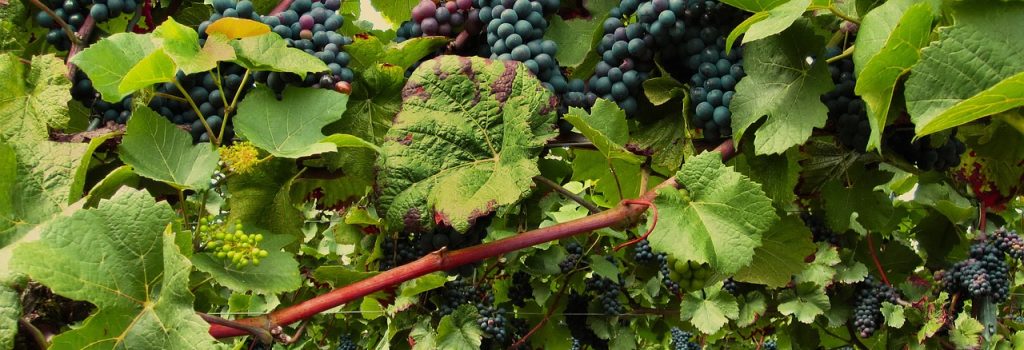
Pinot Noir; the timeless grape
“His lips drink water… but his heart drinks wine.” – EE. Cummings
The basics
Pinot Noir has become in many ways synonymous with an almost timeless love of wine. Not that its history is particularly brilliant, but it has depth in our cultural psyche as a grape that is classy, complex and expensive. The wine will often be pale to medium colour in appearance due to its low tannins and light body.
Pinot Noir is a black grape variety likely to have originated from the Burgundy region of France, which remains its home today. The grape can really only grow in cool and moderate climates to retain the fresh red fruit flavours and prevent burnt skins. As a grape, Pinot Noir is easily prone to disease due to its thin skin making it a notoriously difficult grape to cultivate amongst winemakers.
Generally speaking, Pinot Noir retains a high acidity while having low to medium tannins (depending on the climate). It has primary fresh red fruit flavours (strawberry, red current, raspberry). It is not usually aged in new oak as the influence of these additional flavours will often unbalance the line. If the winemaker does choose to age in oak, these will be large, used oak barrels.
One of the most romantic elements of Pinot Noir is the tertiary flavours it can develop. When aged, it can taste like wet leaves spread over a forest floor, earthy mushrooms and game.
Let's talk terroir; why is Pinot Noir so expensive?
Let me premise this idea by saying, not all Pinot Noir is expensive. Generally speaking, Pinot Noir grown in the Côte d’Or on a grand cru vineyard is expensive. Notably, wine produced by Domaine de la Romanée-Conti can be released at £10,000 per bottle and rise quickly in price when released onto the market. This isn’t uncommon, even Village appellation wines (such as wines from Gevrey-Chambertin AOC and Nuits-Saint-Georges AOC) will start in the region of £100 per bottle and keep rising as they move into premier cru and then grand cru.
One reason Pinot Noir is so expensive is due to where it comes from. The Grand Cru sites in Burgundy are some of the best in the world for growing the grape; they are often south/south-east facing and on a slight slope so they get the longest exposure to the sun throughout the day – allowing the grapes to ripen fully. Moreover, the French believe that “terroir” (‘a sense of place’) is extremely important in how a wine will develop; the sites of date back as far as the Romans, and even further back to more than 200 million years ago when the region of Burgundy was part of a sea. This sea dried over time leaving behind unique limestone soil, with a distinct minerality.
While Pinot Noir for these sites can fetch a high price tag, there are plenty of examples of very reasonable and affordable wines from elsewhere in the world. For example, Pinot Noir from Chile’s Casablanca Valley has moderating climactic influences keeping the grapes cool and fresh. This means its wines will often have aromas of ripe strawberries and cherries. A delicious alternative.

Where does Pinot Noir grow?
Pinot Noir grows in cool and moderate climate regions. With a cool region being classed as having an average growing season temperature of 16.5 degrees celsius or below, and moderate having an average of between 16.5 – 18.5 degrees celsius.
If Pinot Noir is to be produced in a warm climate (18.5 degree celsius +). This it must have moderating climactic influences, such as vineyards at high altitude, with sea breezes or morning fogs to ensure the grapes don’t develop with cooked, unpleasant jammy fruit flavours. The main appeal of Pinot Noir is its fresh fruit flavours balanced with high acidity and low tannin – the conditions must be just right for this profile to thrive.
Moreover, the fact that Pinot Noir is so susceptible to disease and rot means some winemakers may not even risk growing it. If the crop dies from disease, then it is not commercially viable to grow.
Some interesting regions up-and-coming for Pinot Noir are the UK and Tasmania.

Which countries produce Pinot Noir?
Burgundy, France
Gevrey-Chambertin AOC
Nuits-Saint-Georges AOC
Beaune AOC
Pommard AOC
Bourgogne AOC
The most expensive Pinot Noirs in the world come from the Burgundy region of France. The Grand Cru vineyards of the Côte d’Or include the most recognised names in the world of wine, such as Domaine De La Romanée-Conti – whose Chardonnay starts at £10,000 per bottle. Similarly, wines at even the village appellations listed above will fetch a pretty penny – easily entry level wines upwards of £100 per bottle.
Terroir is an extremely important idea for Pinot Noirs from Burgundy; the appellation system (and labelling information) is as follows:
- Bourgogne AOC – Bourgogne AOC wines made from grapes from anywhere within the specific Burgundy region. These are the least expensive and generally will not have as much complexity – although you can often find some bargains if you look hard enough.
- Village-level wines – Throughout Burgundy there are several village level wines, mainly within the Côte de Nuit and the Côte de Beaune. For example, some of the most famous village appellations for Pinot Noir. In total, there are 44 village-level appellations within the Burgundy region and these will be expressly stated on the bottle.
- Premier Cru wines – These make up 10 per cent of wines from Burgundy. Premier Cru wines are from exceptional vineyards within a given village appellation. They are easy to spot as they will say ‘premier cru controlee’ often on the bottle and have the name of the village AOC as well as the vineyard.
- Grand Cru wines – The holy grail of Burgundy Pinot Noir with only 2 per cent of total production being made up of these wines. These vineyards are so renowned they have been awarded their own AOC status (of which there are 33). They are often easily identified by the “le” or “la” before the name on the bottle, ie, “Le Chambertin”.
California, USA
Sonoma
Carneros
Santa Barara County
Mendocino County
Paso Robles
California grows some of the most renowned and complex New World Pinot Noir. As California is generally a warm climate, the key to a successful varietal wine grown here is up to the climactic influences that can cool the grapes. For example, Carneros just north of San Francisco, is affected by the cooling fog that floats north from the San Pablo Bay, keeping vineyard plots cool. Other regions listed above tend to benefit from Pacific Ocean breezes or cooling winds.
Pinot Noir from these areas, while not as light in body as Burgundy, tend to have more ripe red fruit flavours and are more medium in tannin.
Oregon, USA
Willamette Valley
Medford
Pinot Noir is the stand out grape of the Pacific Northwest; with initial plantings being made in the mid 1970s. Due to its moderate climate and ocean breezes, Oregon has optimal growing conditions for the tricky grape.
Wines from Oregon tend to taste of cranberry, red current and sour cherry – with a subtle spiciness. They have a noticeable oak influence, much like their cousins in California.
Germany
Rheingau
Ahr
Baden
Franken
Interestingly, in Germany, Pinot Noir is known locally as Spätburgunder and its the other Old World (European) wine producing area that has infamous, outstanding wines. Geographically, not being too far from Burgundy with similar cool to moderate climates, a German Pinot Noir has similar subtle expressions of red fruit; producing age worthy wines that develop subtle earthy flavours.
New Zealand
Central Otago
Marlborough
Martinborough
New Zealand’s Central Otago region has rocketed to popularity recently due to its intriguing Pinot Noir offering. Central Otago is unique as it is protected from harsh conditions from both a mountainous landscape and sea breezes – wines from the Central Otago region tend to have packed red fruit flavours. Whereas wines from Marlborough, most well known for exceptional Sauvignon Blancs, grow wines that express more underripe red fruit flavours – a focus here on cherry and strawberry.
Australia
Mornington Peninsula
Yarra Valley
Tasmania
Australia offers great value Pinot Noir at a fraction of the cost of Burgundy. As it’s not the most well-known grape in the region, with Cabernet Sauvignon, Shiraz and Sauvignon Blanc leading the charge, only a few areas across Australia produce Pinot Noir. Wines from Australia tend to have cooked fruit flavours, with an almost cooked red plum overtone. Most of the regions, especially Mornington Peninsula and Yarra Valley benefit from a cooling Southern Ocean breeze.
South Africa
Walker Bay
Cape Agulhas
Pinot Noir grows quite moderately in South Africa, with its two main growing regions begin Walker Bay and Cape Agulhas. Both of which have sea breezes to temper the otherwise warm climate. Pinot Noir from South Africa tend to be packed with red fruit and slightly higher tannins than elsewhere.
Chile
Casablanca Valley
Central Valley
Chilean wines are extraordinary value and this New World wine region is producing Pinot Noirs of a excellent calibre. Wines from these areas are lucky to have both fog and coastal influences to keep the grapes cool and the flavours fresh.

Food pairings for Pinot Noir
The most important thing to remember when pairing Pinot Noir is its body. A light bodied red can easily be overwhelmed by heavy red meats or charismatic flavours. As a result, picking the perfect pairing for your Pinot Noir should be as follows:
Mushroom risotto, mushroom pasta – mushroom anything!
The same tertiary flavours from an age worthy Pinot Noir are earth, forest floor… and mushrooms! The same dirt that you wipe off a mushroom before cooking has the same nutrients absorbed by the vine for your Pinot Noir. Make sure the sauce isn’t too creamy though, the mushroom should be the stand out feature to make it the best pairing.
Pair with: More subtle, lighter body Pinot Noir – Burgundy or Northern German regions (Ahr or Rheingau).
Fatty fish – Salmon or Tuna
Whoever said that you should only pair white wine with fish is categorically wrong. Some of the lighter bodied reds can easily hold up to the weighty mouthfeel of a grilled tuna steak. Not only hold up to in fact, but compliment perfectly.
Pair with: Pinot Noir from Walker Bay or a warmer new world climate.
Lamb
With the right seasoning and a slightly tougher, more earthy cooking style – Pinot Noir is a perfect accompaniment to lamb. Don’t forget, ‘what goes together, grows together’ and this pairing isn’t more obvious than lambs and New Zealand.
Pair with: Chablis or another unoaked Chardonnay
Soft cheese
The mix between high acid and additional butter-led flavours from Chardonnay’s oak influences will pair beautifully with lots of different cheeses. Try soft cheeses especially like Camembert, or semi-soft cheeses, such as Gorgonzola or Cambozola.
Pair with: Slightly fruity, high acid Chardonnays, such as wines from Adelaide Hills or Yarra Valley, Australia.
Pork
Whoever said pork and white wines couldn’t mix were wrong! I mean, did someone even say that or am I just trying to make a point here? Basically, the heavenly mix of pork chops and a slightly oaked chardonnay at a BBQ is one step closer to wine-topic.
Pair with: More medium bodied wines, something from Hawke’s Bay or the South of France will work.
